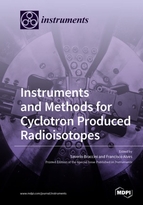Instruments and Methods for Cyclotron Produced Radioisotopes
A special issue of Instruments (ISSN 2410-390X).
Deadline for manuscript submissions: closed (31 December 2018) | Viewed by 90934
Special Issue Editors
Interests: medical applications of particle physics; particle accelerators; particle detectors; radiation protection; radioisotopes for theragnostics
Special Issues, Collections and Topics in MDPI journals
Interests: medical cyclotrons; positron emission tomography (PET); radioisotope production
Special Issues, Collections and Topics in MDPI journals
Special Issue Information
Dear Colleagues,
The 17th Workshop on Targets and Target Chemistry (WTTC17) was held in Coimbra (Portugal) on 27–31 August 2018. A few months before, the 13th Workshop of the European Cyclotron Network (CYCLEUR) took place in Lisbon (Portugal) on 23–24 November 2017. These two events reassembled major experts in the field of radioisotope production, targets, target chemistry and cyclotrons. In the last few years, significant advances have been obtained in these fields with direct implications for science and society. Instruments and methods, originally developed for nuclear and particle physics, played a crucial role and further developments are expected. In particular, the production of radioisotopes for both medical diagnostics and therapy—the so-called “theranostics”—could produce a breakthrough in nuclear medicine. This Special Issue is intended to collect original scientific contributions on the latest developments on instruments and methods for medical and research cyclotrons as well as on target and target chemistry for the production of radioisotopes.
Prof. Dr. Saverio BracciniProf. Dr. Francisco Alves
Guest Editors
Manuscript Submission Information
Manuscripts should be submitted online at www.mdpi.com by registering and logging in to this website. Once you are registered, click here to go to the submission form. Manuscripts can be submitted until the deadline. All submissions that pass pre-check are peer-reviewed. Accepted papers will be published continuously in the journal (as soon as accepted) and will be listed together on the special issue website. Research articles, review articles as well as short communications are invited. For planned papers, a title and short abstract (about 100 words) can be sent to the Editorial Office for announcement on this website.
Submitted manuscripts should not have been published previously, nor be under consideration for publication elsewhere (except conference proceedings papers). All manuscripts are thoroughly refereed through a single-blind peer-review process. A guide for authors and other relevant information for submission of manuscripts is available on the Instructions for Authors page. Instruments is an international peer-reviewed open access quarterly journal published by MDPI.
Please visit the Instructions for Authors page before submitting a manuscript. The Article Processing Charge (APC) for publication in this open access journal is 1400 CHF (Swiss Francs). Submitted papers should be well formatted and use good English. Authors may use MDPI's English editing service prior to publication or during author revisions.
Keywords
- cyclotrons
- radioisotope production
- solid, liquid and gas targets
- theranostics






